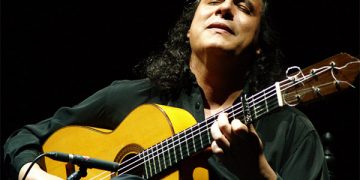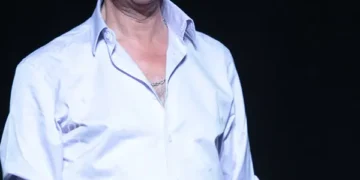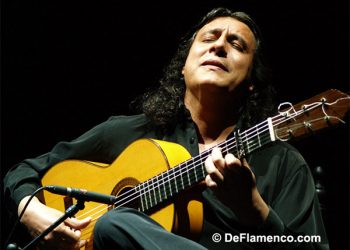|
Zatania
| Daily coverage BIENAL DE FLAMENCO sponsored by: |
Dance: María Pagés, María Morales, Sonia
Fernández, Mar Jurado, Cristina Tomé, Guadalupe Torres,
José Barrios, Emilio Herrera, Abel Harana, Alberto Ruíz,
Joaquín Mulero. Cante: Ismael de la Rosa ‘Bolita’.
Guitar: José Carrillo ‘Fyty’, Rubén Lebaniegos,
Isaac Muñoz. Percussion: Chema Uriarte, Francisco Alcaide.
Special guest artists: Tsidii Le Loka and Paco del Pozo.
With this work it’s safe to say María Pagés
has crossed over. And it’s an important loss for flamenco
considering what this woman could have continued to contribute.
She has signed her heart and soul away to modern dance, to the theatre,
to the world. Her intelligently avant-garde vision, her choreographies
and her excellent theater sense have always been noteworthy, but
until now flamenco has continued to have a fundamental presence
in her person and work.

antes de una guerra” flamenco singing and guitar play such
a marginal role they could be eliminated entirely and no one would
notice – flamenco has been sent to bed without supper, like
a naughty child, loved by its parents but whose ruckus has become
annoying. There are snippets of cante, and here and there a bit
of heelwork and polkadots, but what dominates is pop culture retro
music, especially the thirties, forties and fifties – Angelillo,
Concha Piquer, Louis Armstrong – in duly scratchy recordings
and choreographed with an aesthetic sense that complements the whole.
Avant-garde representing the past, only María Pagés
could get away with it, because without a doubt it works splendidly
as theater. This is worlds apart from certain works of questionable
taste we’ve seen at this Bienal de Flamenco where major stars
have looked like the king from the fairy tale in his new “clothes”
with carefully elaborated shows built around contrivances that don’t
come off or worse yet, smell of opportunism.
María Pagés is artistically sincere, her choreographies
are precisely that, with none of the unfortunate “dance-class
effect” others fall into, and generally speaking the work
is dynamic, fresh and entertaining. As is typical of this dancer
– the keys are refusing to write the words ‘flamenco
dancer’ – she combines incongruous and surreal elements
to jostle the senses and make us laugh a bit. A fake intermission
is nothing more that the ad for a popular brand of chocolate milk:
“I’m the little black boy from Africa…”
choreographed with moves that illustrate the words of the old TV
jingle. But not everything is light and superficial, the show has
a serious underpinning. Works with a social agenda are now quite
the fashion and Pagés is sending an antiwar antiterrorism
message of peace and solidarity. The show finishes as she moves
(more than actually dance, the woman sculpts) to the music of John
Lennon’s ‘Imagine’ while a map of the world is
projected against the backdrop.
Avant-garde representing the past, only
María Pagés could get away with it
A less fortunate decision is the inclusion of South African singer
Tsidii Le Loka, like Pagés a veteran of Riverdance. When
hers is the voice responsible for filling the compás for
a dance, not with cante but with her own music, we smile complacently
at the kind of guts it takes to do something like that. But that’s
not half the story. The flashy Broadway star moves from behind the
guitarists to sing up front, “p’alante” as they
say in flamenco of soloists, and before you know it, we’re
watching “The Tsidii Le Loka” show. At this point one
begins to wonder if there isn’t a complaints desk at musicals,
or if a legally-established minimum percentage of flamenco doesn’t
exist for shows presented under the banner of “flamenco”.
She has a beautiful voice but the pseudo-African contortions, rolling
eyes like the old blackface singers and sudden shouts only managed
to provoke a profound sense of embarrassment in this reviewer. The
audience ate it all up, but it’s to be assumed that the presence
of Julio Iglesias or Madonna would touch off even greater paroxysms
of delight.
We left the Maestranza theater and knew we weren’t on Broadway
because the Guadalquivir river and the Torre del Oro were right
where we left them upon entering. María Pagés tried
to demonstrate that flamenco can exist without those elements some
of us consider essential, but the absence of a flamenco feeling
in this presentation confirmed exactly the opposite, that flamenco
may exist without dance and without guitar, but without cante, never.
|
|























